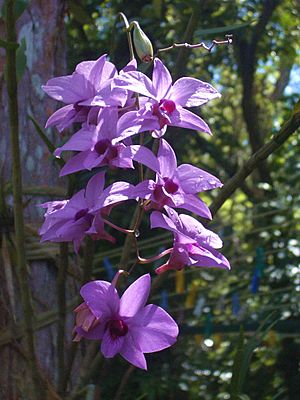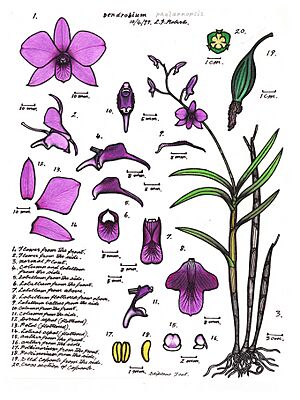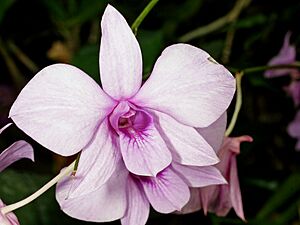Cooktown orchid facts for kids
Quick facts for kids Cooktown orchid |
|
|---|---|
 |
|
| Conservation status | |
| Scientific classification | |
| Genus: |
Dendrobium
|
| Species: |
bigibbum
|
| Synonyms | |
|
|
The Cooktown orchid (scientific name: Dendrobium bigibbum) is a beautiful flower. It is also known as the mauve butterfly orchid. This orchid grows on other plants or rocks, not in the soil. It belongs to the family of orchids called Orchidaceae.
The Cooktown orchid has thick, cylinder-shaped stems called pseudobulbs. Each stem has three to five green or purplish leaves. Its flowering stems arch gracefully and can have up to twenty flowers. These flowers are usually a lovely lilac-purple color. You can find this orchid in tropical North Queensland, Australia, and in New Guinea.
There are four different types, or varieties, of the Cooktown orchid. Each of these types was once thought to be a separate species.
Contents
What Does the Cooktown Orchid Look Like?
The Cooktown orchid is an epiphytic or lithophytic plant. This means it grows on other plants or on rocks, not in the ground. It has green or purplish pseudobulbs that are about 20 to 120 centimeters (8 to 47 inches) long. These stems are about 1.5 to 2 centimeters (0.6 to 0.8 inches) wide.
Each pseudobulb has three to five leaves that are shaped like an egg. These leaves are about 10 to 15 centimeters (4 to 6 inches) long. They are about 3 to 3.5 centimeters (1.2 to 1.4 inches) wide.
The flowering stems arch outwards and are about 20 to 40 centimeters (8 to 16 inches) long. They can have anywhere from two to twenty flowers. These flowers are usually lilac-purple, but sometimes they can be bluish or pinkish.
The flowers are resupinate, which means they appear upside down. They are about 2 to 3 centimeters (0.8 to 1.2 inches) long and 3 to 7 centimeters (1.2 to 2.8 inches) wide. The size depends on the specific variety.
The outer parts of the flower, called sepals, are oblong or egg-shaped. They are about 2 to 3 centimeters (0.8 to 1.2 inches) long. The top sepal stands upright or bends back. The side sepals spread wide apart.
The petals are broadly egg-shaped and are about 2.5 to 3 centimeters (1 to 1.2 inches) long and wide. The labellum, or "lip," is a special petal. It is about 2 to 2.6 centimeters (0.8 to 1 inch) long and 2 to 2.8 centimeters (0.8 to 1.1 inches) wide. It has three parts, or lobes. The side lobes stand upright. The middle lobe has four or five ridges and a fuzzy patch in the middle.
Cooktown orchids usually bloom from February to July.
How Was the Cooktown Orchid Named?
The Cooktown orchid was first officially described in 1852. This was done by a scientist named John Lindley. His description was published in a book called Paxton's Flower Garden.
Today, the World Checklist of Selected Plant Families (WCSP) recognizes four main types of this orchid:
- Dendrobium bigibbum var. bigibbum: This type is also called the mauve butterfly orchid. It has a white spot in the center of its labellum. It grows in low areas on Cape York Peninsula, some Torres Strait Islands, and southern New Guinea.
- Dendrobium bigibbum var. compactum: This type grows on rocks. It is found in a small area of the wet tropics at about 250 meters (820 feet) elevation.
- Dendrobium bigibbum var. schoederianum: This type has flowers of different colors. It only grows on Larat Island in the Tanimbar group.
- Dendrobium bigibbum var. superbum: This type is the Cooktown orchid that most people know. It has the largest flowers in the group. Unlike the mauve butterfly orchid, it does not have a white spot in the center of its labellum. It grows between Cooktown and Mount Molloy.
The way these orchids are classified has been a bit confusing over time. Especially the scientific name for the Cooktown orchid.
Queensland's State Flower
On November 19, 1959, the Cooktown Orchid was chosen as the official flower of Queensland, Australia. This happened as Queensland was getting ready to celebrate its 100th birthday.
The government wanted a native flower that was:
- Easy to grow.
- Found only in Queensland.
- Pretty and unique.
- Close to the State's color, maroon.
The Cooktown orchid fit all these requirements. It was one of the top choices. Other flowers considered were the red silky oak, the umbrella tree, and the wheel-of-fire. A local newspaper, The Courier-Mail, asked its readers for more ideas. In a public vote, the Cooktown orchid came in first place.
In 1968, the Cooktown orchid was even featured on an Australian postage stamp!
Where Does the Cooktown Orchid Grow?
This orchid species grows in many different places. You can find it on trees and rocks in rainforests. It also grows in coastal scrub, near rivers, in swamps, and in open forests. Its natural home is in tropical Queensland, southern New Guinea, and one island in Indonesia.
Is the Cooktown Orchid Protected?
Yes, the Cooktown orchid is listed as "vulnerable" under an Australian law called the Environment Protection and Biodiversity Conservation Act 1999. This means it is at risk of disappearing.
The main dangers to this orchid are:
- "Settlement and visitor pressures": This means problems caused by people living in or visiting its habitat.
- Wrong fire management: Fires that are too frequent or too strong can harm the plants.
- Illegal collection: People sometimes try to take these orchids from their natural homes without permission. This is against the law.
Growing Cooktown Orchids at Home
It is against the law to collect the Cooktown orchid from its natural environment without a special license.
If you want to grow them, commercially grown plants are available. They like a dry, sunny spot. They need very little watering. The temperature should not fall below 13 degrees Celsius (55 degrees Fahrenheit). If you live in a cooler climate, you might need a special greenhouse or "bush-house" to keep them warm enough.
See also
 In Spanish: Dendrobium bigibbum para niños
In Spanish: Dendrobium bigibbum para niños
Images for kids







